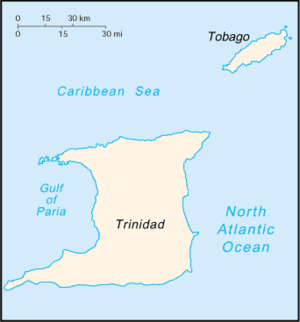
Gulf of Paria
Encyclopedia

Trinidad
Trinidad is the larger and more populous of the two major islands and numerous landforms which make up the island nation of Trinidad and Tobago. It is the southernmost island in the Caribbean and lies just off the northeastern coast of Venezuela. With an area of it is also the fifth largest in...
(Republic of Trinidad and Tobago
Trinidad and Tobago
Trinidad and Tobago officially the Republic of Trinidad and Tobago is an archipelagic state in the southern Caribbean, lying just off the coast of northeastern Venezuela and south of Grenada in the Lesser Antilles...
) and the east coast of Venezuela
Venezuela
Venezuela , officially called the Bolivarian Republic of Venezuela , is a tropical country on the northern coast of South America. It borders Colombia to the west, Guyana to the east, and Brazil to the south...
. This sheltered body of water is considered to be one of the best natural harbours on the Atlantic coast of the Americas
Americas
The Americas, or America , are lands in the Western hemisphere, also known as the New World. In English, the plural form the Americas is often used to refer to the landmasses of North America and South America with their associated islands and regions, while the singular form America is primarily...
. It was originally named Golfo de la Ballena (the Gulf of the Whale) by Christopher Columbus
Christopher Columbus
Christopher Columbus was an explorer, colonizer, and navigator, born in the Republic of Genoa, in northwestern Italy. Under the auspices of the Catholic Monarchs of Spain, he completed four voyages across the Atlantic Ocean that led to general European awareness of the American continents in the...
, but the 19th Century whaling
Whaling
Whaling is the hunting of whales mainly for meat and oil. Its earliest forms date to at least 3000 BC. Various coastal communities have long histories of sustenance whaling and harvesting beached whales...
industry eliminated whales from the area and populations have never recovered.
Cartographic sources of the late 18th century repeatedly refer to the gulf as Golfo Triste (the Sad Gulf).
The Gulf of Paria is connected to the Caribbean Sea
Caribbean Sea
The Caribbean Sea is a sea of the Atlantic Ocean located in the tropics of the Western hemisphere. It is bounded by Mexico and Central America to the west and southwest, to the north by the Greater Antilles, and to the east by the Lesser Antilles....
to the north through the Bocas del Dragón
Bocas del Dragón
The Bocas del Dragón is the name of the series of straits separating the Gulf of Paria from the Caribbean Sea. There are four Bocas, from west to east they are:...
(or Dragons' Mouth) between the Paria Peninsula
Paria Peninsula
Paria Peninsula is a large peninsula in Sucre State, northern Venezuela. It separates the Gulf of Paria and Caribbean Sea. Península de Paria National Park is located on the peninsula...
of Venezuela and the Chaguaramas Peninsula, and to the Columbus Channel
Columbus Channel
The Columbus Channel is the narrow body of water between the south coast of the island of Trinidad and the Venezuelan mainland. The Columbus Channel connects the Gulf of Paria with the Atlantic Ocean. It is also known as the Serpent's Mouth....
to the south through the Boca del Serpiente
Boca del Serpiente
The Serpent's Mouth is a strait lying between Icacos Point in southwest Trinidad and Tobago and the north coast of Venezuela. It leads from the Atlantic Ocean to the Gulf of Paria. It is also known as the Columbus Channel....
(Serpent's Mouth) between the Cedros Peninsula and the Orinoco Delta.
The Gulf of Paria is a brackish water body - wet season
Wet season
The the wet season, or rainy season, is the time of year, covering one or more months, when most of the average annual rainfall in a region occurs. The term green season is also sometimes used as a euphemism by tourist authorities. Areas with wet seasons are dispersed across portions of the...
salinities
Salinity
Salinity is the saltiness or dissolved salt content of a body of water. It is a general term used to describe the levels of different salts such as sodium chloride, magnesium and calcium sulfates, and bicarbonates...
are below 23 ppt (parts per thousand). The extensive mangrove
Mangrove
Mangroves are various kinds of trees up to medium height and shrubs that grow in saline coastal sediment habitats in the tropics and subtropics – mainly between latitudes N and S...
s along the Venezuelan and Trinidadian coastlines are important wildlife habitat and probably play a crucial role in regional fisheries. The Gulf itself is an important fishery. Major ports include the Port of Port of Spain
Port of Spain
Port of Spain, also written as Port-of-Spain, is the capital of the Republic of Trinidad and Tobago and the country's third-largest municipality, after San Fernando and Chaguanas. The city has a municipal population of 49,031 , a metropolitan population of 128,026 and a transient daily population...
and the Port of Point Lisas
Point Lisas
Point Lisas is the site of the Point Lisas Industrial Estate and the Port of Point Lisas, both of which are managed by Plipdeco...
in Trinidad and the Port of Pedernales in Venezuela.

